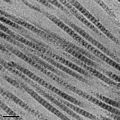Collagen facts for kids
Collagen is a special group of proteins found naturally. It is only found in animals, especially in their flesh and connective tissues. Think of it as the "glue" that holds animal bodies together!
Collagen is the main part of connective tissue. It is also the most common protein in mammals, like humans. About 25% to 35% of all the protein in your body is collagen.
You can find collagen in many places in your body. It forms long, strong fibers in tissues like your tendons, ligaments, and skin. It is also found in your cornea (part of your eye), cartilage, bone, blood vessels, your gut, and the discs between your backbones.
Even your muscles have a little collagen, about 1% to 2% of their tissue. In strong, rope-like muscles, it can make up about 6% of their weight.
Did you know that Gelatin is made from collagen? Gelatin, which is used in food and other products, is simply collagen that has been changed by a process called hydrolysis.
What is Collagen?
Collagen is like a super strong building block for your body. It helps give structure and support to many parts. Imagine it as tiny ropes that are twisted together to make even stronger cables. These "cables" help your skin stay firm and your bones stay strong.
Where is Collagen Found?
Collagen is everywhere in animals! It's a key part of your:
- Skin: It helps keep your skin stretchy and smooth.
- Bones: It gives bones their strength and flexibility.
- Tendons: These connect your muscles to your bones. Collagen makes them tough.
- Ligaments: These connect bones to other bones. Collagen helps them hold joints together.
- Cartilage: This smooth tissue covers the ends of bones in joints. Collagen helps it absorb shock.
How is Collagen Made?
Your body makes collagen using special cells. These cells build long chains of proteins. Three of these chains then twist together to form a triple helix, like a braided rope. Many of these twisted ropes then join up to make even bigger fibers. These fibers are what give tissues their amazing strength.
Images for kids
-
Three polypeptides coil to form tropocollagen. Many tropocollagens then bind together to form a fibril, and many of these then form a fibre.
See also
 In Spanish: Colágeno para niños
In Spanish: Colágeno para niños






